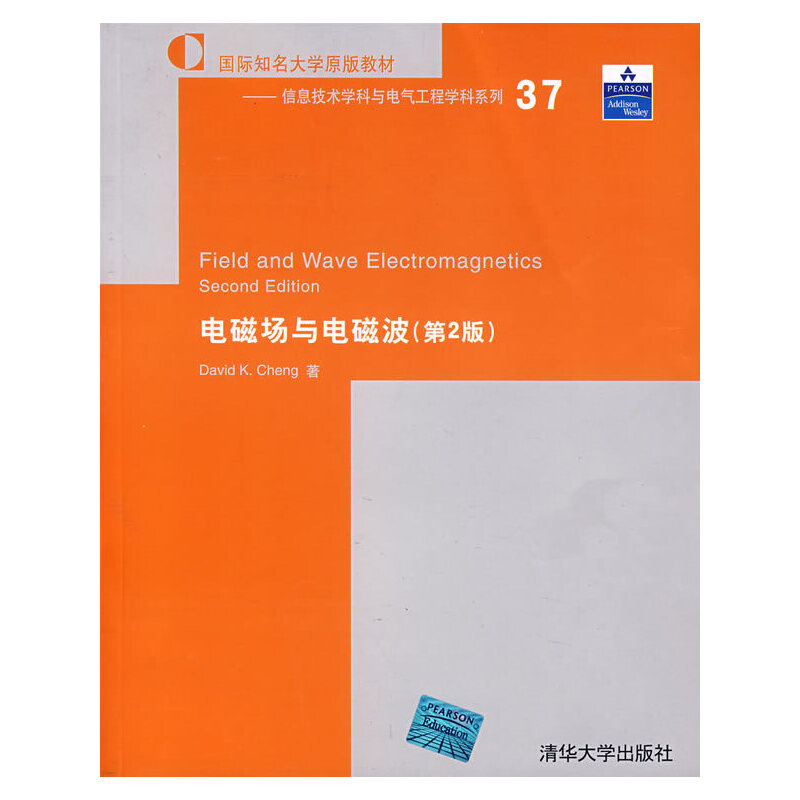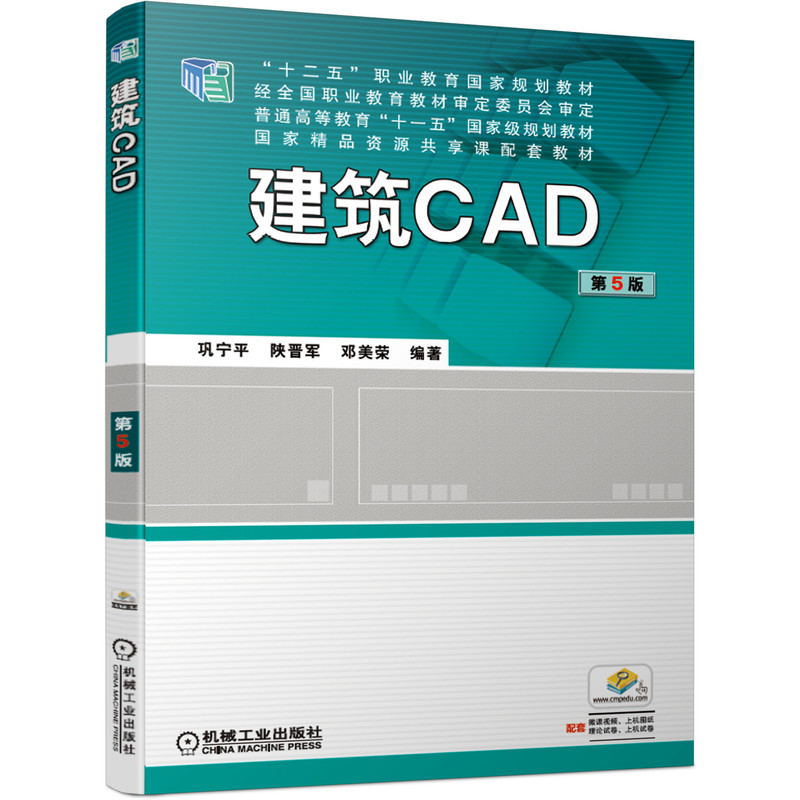电磁场与电磁波(第二版) / 国际知名大学原版教材·信息技术学科与电气工程学科系列
¥69.00定价
作者: 影印
出版时间:2015-05
出版社:清华大学出版社
- 清华大学出版社
- 9787302152125
- 1-6
- 57524
- 16开
- 2015-05
- 工学
- 电子科学与技术
- O441.4
- 机电类
内容简介
本书是关于电磁场与电磁波的一本很有特色的教材,取材新颖,笔法灵活,逻辑性强。教材从矢量分析和场论人手,以简捷清晰的方式建立了电磁模型。紧接着,全面地阐述了电磁场和电磁波的基础理论,包括静电场、静磁场、稳恒电流的场、边值问题的经典解法、时变电磁场与麦克斯韦方程组、平面电磁波及其传播、传输线、阻抗圆图、微带线、波导与谐振腔、天线与电磁辐射、电磁屏蔽等内容。本书除了内容全面之外,还具有很大的灵活性,这是因为全书的内容安排具有较完整的模块性,从而可以灵活地取舍和组合成适合不同行业和不同对象的电磁场与电磁波的教材。
本书特别适合用作理科大学本科高年级和工科院校硕士研究生基础课的英文授课教材或英文参考书。
本书特别适合用作理科大学本科高年级和工科院校硕士研究生基础课的英文授课教材或英文参考书。
目录
1 The Electromagnetic Model 1-1 Introduction 1-2 The Electromagnetic Model 1-3 SI Units and Universal Constants Review Questions2 Vector Analysis 2-1 Introduction 2-2 Vector Addition and Subtraction 2-3 Products of Vectors 2-3.1 Scalar or Dot Product 2-3.2 Vector or Cross Product 2-3.3 Product of Three Vectors 2-4 Orthogonal Coordinate Systems 2-4.1 Cartesian Coordinates 2-4.2 Cylindrical Coordinates 2-4.3 Spherical Coordinates 2-5 Integrals Containing Vector Functions 2-6 Gradient of a Scalar Field 2-7 Divergence of a Vector Field 2-8 Divergence Theorem 2-9 Curt of a Vector Field 2-10 Stokes's Theorem 2-11 Two Null Identities 2-11.1 Identity Ⅰ 2-11.2 Identity Ⅱ 2-12 Helmholtz's Theorem Review Questions Problems3 Static Electric Fields 3-1 Introduction 3-2 Fundamental Postulates of Electrostatics in Free Space 3-3 Coulomb's Law 3-3.1 Electric Field Due to a System of Discrete Charges 3-3.2 Electric Field Due to a Continuous Distribution of Charge 3-4 Gauss's Law and Applications 3-5 Electric Potential 3 5.1 Electric Potential Due to a Charge Distribution 3-6 Conductors in Static Electric Field 3-7 Dielectrics in Static Electric Field 3-7.1 Equivalent Charge Distributions of Polarized Dielectrics 3-8 Electric Flux Density and Dielectric Constant 3-8.1 Dielectric Strength 3-9 Boundary Conditions for Electrostatic Fields 3-10 Capacitance and Capacitors 3-10.1 Series and Parallel Connections of Capacitors 3-10.2 Capacitances in Multiconductor Systems 3-10.3 Electrostatic Shielding 3-11 Electrostatic Energy and Forces 3-11.1 Electrostatic Energy in Terms of Field Quantities 3-11.2 Electrostatic Forces Review Questions Problems4 Solution of Electrostatic Problems 4-1 Introduction 4-2 Poisson's and Laplace's Equations 4-3 Uniqueness of Electrostatic Solutions 4-4 Method of Images 4-4.1 Point Charge and Conducting Planes 4-4.2 Line Charge and Parallel Conducting Cylinder 4-4.3 Point Charge and Conducting Sphere 4-4.4 Charged Sphere and Grounded Plane 4-5 Boundary-Value Problems in Cartesian Coordinates 4-6 Boundary-Value Problems in Cylindrical Coordinates 4-7 Boundary-Value Problems in Spherical Coordinates Review Questions Problems5 Steady Electric Currents 5-1 Introduction 5-2 Current Density and Ohm's Law 5-3 Electromotive Force and Kirchhoff's Voltage Law 5-4 Equation of Continuity and Kirchhoff's Current Law 5-5 Power Dissipation and Joule's Law 5-6 Boundary Conditions for Current Density 5-7 Resistance Calculations Review Questions Problems6 Static Magnetic Fields 6-1 Introduction 6-2 Fundamental Postulates of Magnetostatics in Free Space 6-3 Vector Magnetic Potential 6-4 The Biot-Savart Law and Applications 6-5 The Magnetic Dipole 6-5.1 Scalar Magnetic Potential 6-6 Magnetization and Equivalent Current Densities 6-6.1 Equivalent Magnetization Charge Densities 6-7 Magnetic Field Intensity and Relative Permeability 6-8 Magnetic Circuits 6-9 Behavior of Magnetic Materials 6-10 Boundary Conditions for Magnetostatic Fields 6-11 Inductances and Inductors 6-12 Magnetic Energy 6-12.1 Magnetic Energy in Terms of Field Quantities 6-13 Magnetic Forces and Torques 6-13.1 Hall Effect 6-13.2 Forces and Torques on Current-Carrying Conductors 6-13.3 Forces and Torques in Terms of Stored Magnetic Energy 6-13.4 Forces and Torques in Terms of Mutual Inductance Review Questions Problems7 Time-Varying Fields and Maxwelrs Equations 7-1 Introduction 7-2 Faraday's Law of Electromagnetic Induction 7-2.1 A Stationary Circuit in a Time-Varying Magnetic Field 7-2.2 Transformers 7-2.3 A Moving Conductor in a Static Magnetic Field 7-2.4 A Moving Circuit in a Time-Varying Magnetic Field 7-3 Maxwell's Equations 7-3.1 Integral Form of Maxwell's Equations 7-4 Potential Functions 7-5 Electromagnetic Boundary Conditions 7-5.1 Interface between Two Lossless Linear Media 7-5.2 Interface between a Dielectric and a Perfect Conductor 7-6 Wave Equations and Their Solutions 7-6.1 Solution of Wave Equations for Potentials 7-6.2 Source-Free Wave Equations 7-7 Time-Harmonic Fields 7-7.1 The Use of Phasors—A Review 7-7.2 Time-Harmonic Electromagnetics 7-7.3 Source-Free Fields in Simple Media 7-7.4 The Electromagnetic Spectrum Review Questions Problems8 Plane Electromagnetic Waves 8-1 Introduction 8-2 Plane Waves in Lossless Media 8-2.1 Doppler Effect 8-2.2 Transverse Electromagnetic Waves 8-2.3 Polarization of Plane Waves 8-3 Plane Waves in Lossy Media 8-3.1 Low-Loss Dielectrics 8-3.2 Good Conductors 8-3.3 Ionized Gases 8-4 Group Velocity 8-5 Flow of Electromagnetic Power and the Poynting Vector 8-5.1 Instantaneous and Average Power Densities 8-6 Normal Incidence at a Plane Conducting Boundary 8-7 Oblique Incidence at a Plane Conducting Boundary 8-7.1 Perpendicular Polarization 8-7.2 Parallel Polarization 8-8 Normal Incidence at a Plane Dielectric Boundary 8-9 Normal Incidence at Multiple Dielectric Interfaces 8-9.1 Wave Impedance of the Total Field 8-9.2 Impedance Transformation with Multiple Dielectrics 8-10 Oblique Incidence at a Plane Dielectric Boundary 8-10.l Total Reflection 8-10.2 Perpendicular Polarization 8-10.3 Parallel Polarization Review Questions Problems9 Theory and Applications of Transmission Lines 9-1 Introduction 9-2 Transverse Electromagnetic Wave along a Parallel-Plate Transmission Line 9-2.1 Lossy Parallel-Plate Transmission Lines 9-2.2 Microstrip Lines 9-3 General Transmission-Line Equations 9-3.1 Wave Characteristics on an Infinite Transmission Line 9-3.2 Transmission-Line Parameters 9-3.3 Attenuation Constant from Power Relations 9-4 Wave Characteristics on Finite Transmission Lines 9-4.1 Transmission Lines as Circuit Elements 9-4.2 Lines with Resistive Termination 9-4.3 Lines with Arbitrary Termination 9-4.4 Transmissionq~ine Circuits 9-5 Transients on Transmission Lines 9-5.1 Reflection Diagrams 9-5.2 Pulse Excitation 9-5.3 Initially Charged Line 9-5.4 Line with Reactive Load 9-6 The Smith Chart 9-6.1 Smith-Chart Calculations for Lossy Lines 9-7 Transmission-Line Impedance Matching 9-7.1 Impedance Matching by Quarter-Wave Transformer 9-7.2 Single-Stub Matching 9-7.3 Double-Stub Matching Review Questions Problems10 Waveguides and Cavity Resonators 10-1 Introduction 10-2 General Wave Behaviors along Uniform Guiding Structures 10-2.1 Transverse Electromagnetic Waves 10-2.2 Transverse Magnetic Waves 10-2.3 Transverse Electric Waves 10-3 Parallel-Plate Waveguide 10-3.1 TM Waves between Parallel Plates 10-3.2 TE Waves between Parallel Plates 10-3.3 Energy-Transport Velocity 10-3.4 Attenuation in Parallel-Plate Waveguides 10-4 Rectangular Waveguides 10-4.1 TM Waves in Rectangular Waveguides 10-4.2 TE Waves in Rectangular Waveguides 10-4.3 Attenuation in Rectangular Waveguides 10-4.4 Discontinuities in Rectangular Waveguides 10-5 Circular Waveguides 10-5.1 Bessel's Differential Equation and Bessel Functions 10-5.2 TM Waves in Circular Waveguides 10-5.3 TE Waves in Circular Waveguides 10-6 Dielectric Waveguides 10-6.1 TM Waves along a Dielectric Slab 10-6.2 TE Waves along a Dielectric Slab 10-6.3 Additional Comments on Dielectric Waveguides 10-7 Cavity Resonators 10-7.1 Rectangular Cavity Resonators 10-7.2 Quality Factor of Cavity Resonator 10-7.3 Circular Cavity Resonator Review Questions Problems11 Antennas and Radiating Systems 11-1 Introduction 11-2 Radiation Fields of Elemental Dipoles 11-2.1 The Elemental Electric Dipole 11-2.2 The Elemental Magnetic Dipole 11-3 Antenna Patterns and Antenna Parameters 11-4 Thin Linear Antennas 11-4.1 The Half-Wave Dipole 11-4.2 Effective Antenna Length 11-5 Antenna Arrays 11-5.1 Two-Element Arrays 11-5.2 General Uniform Linear Arrays 11-6 Receiving Antennas 11-6.1 Internal Impedance and Directional Pattern 11-6.2 Effective Area 11-6.3 Backscatter Cross Section 11-7 Transmit-Receive Systems 11-7.1 Friis Transmission Formula and Radar Equation 11-7.2 Wave Propagation near Earth's Surface 11-8 Some Other Antenna Types 11-8.1 Traveling-Wave Antennas 11-8.2 Helical Antennas 11-8.3 Yagi-Uda Antenna 11-8.4 Broadband Antennas 11-9 Aperture Radiators References Review Questions ProblemsAppendixesA Symbols and Units A-1 Fundamental SI (Rationalized MKSA) Units A-2 Derived Quantities A-3 Multiples and Submultiples of UnitsB Some Useful Material Constants B-1 Constants of Free Space B-2 Physical Constants of Electron and Proton B-3 Relative Permittivities(Dielectric Constants) B-4 Conductivities B-5 Relative PermeabilitiesC Index of TablesGeneral BibliographyAnswers to Selected ProblemsIndexSome Useful Items Some Useful Vector Identities Gradient, Divergence, Curl, and Laplacian Operations in Cartesian Coordinates Gradient, Divergence, Curl, and Laplacian Operations in Cylindrical and Spherical Coordinates







